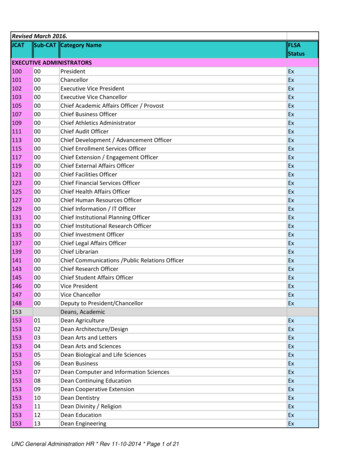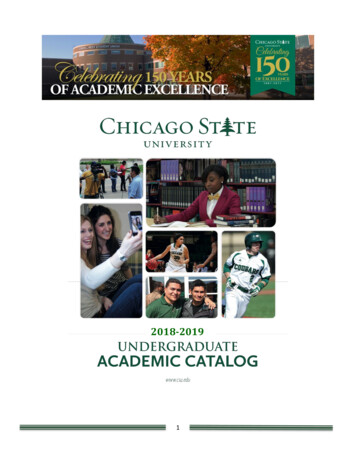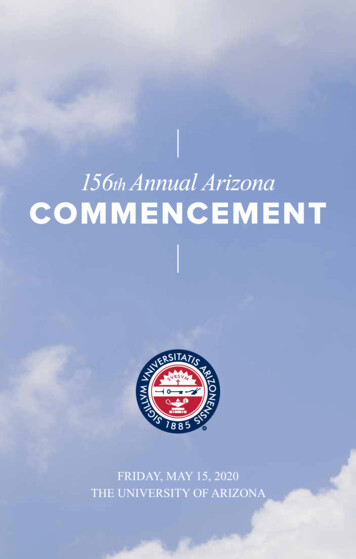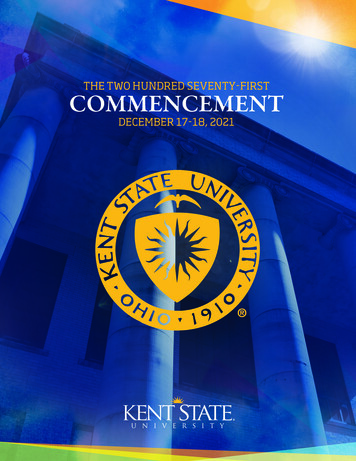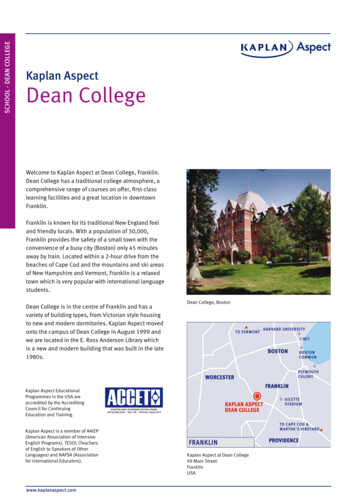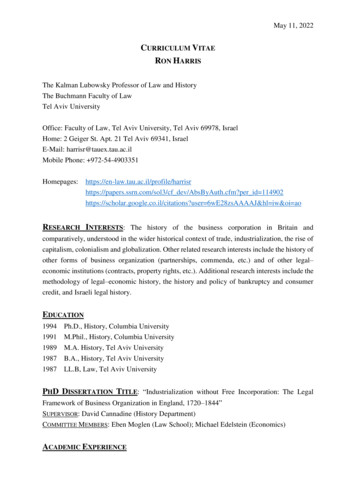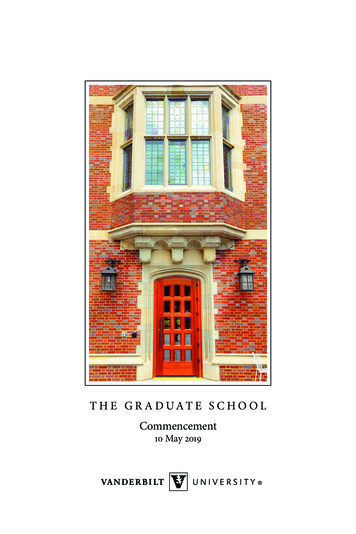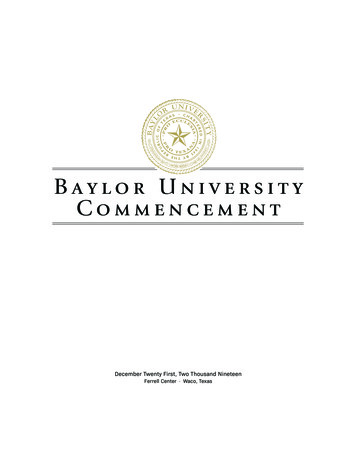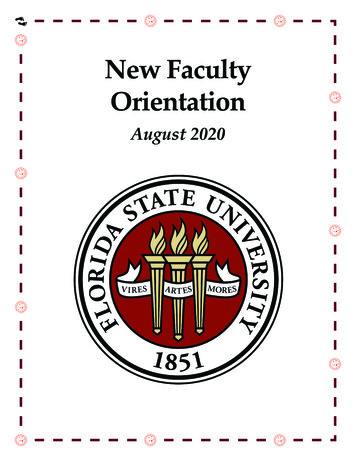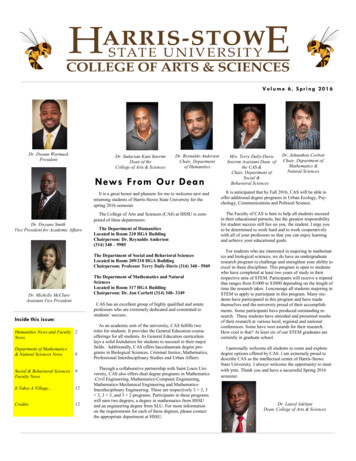
Transcription
Volume 6, Spring 2016Dr. Dwaun WarmackPresidentDr. Sudarsan Kant InterimDean of theCollege of Arts & SciencesDr. Reynaldo AndersonChair, Departmentof HumanitiesNews From Our DeanDr. Dwyane SmithVice President for Academic AffairsIt is anticipated that by Fall 2016, CAS will be able tooffer additional degree programs in Urban Ecology, Psychology, Communications and Political Science.The College of Arts and Sciences (CAS) at HSSU is comprised of three departments:The Faculty of CAS is here to help all students succeedin their educational pursuits, but the greatest responsibilityfor student success still lies on you, the student. I urge youto be determined to work hard and to work cooperativelywith all of your professors so that you can enjoy learningand achieve your educational goals.The Department of HumanitiesLocated in Room 210 HGA BuildingChairperson: Dr. Reynaldo Anderson(314) 340 – 5985The Department of Mathematics and NaturalSciencesLocated in Room 317 HGA BuildingChairperson: Dr. Jon Corbett (314) 340- 3349CAS has an excellent group of highly qualified and astuteprofessors who are extremely dedicated and committed tostudents’ success.Inside this issue:Humanities News and Faculty 2NewsDepartment of Mathematics& Natural Sciences News8Social & Behavioral SciencesFaculty News9It Takes A Village.12Credits12Dr. Johnathon CorbettChair, Department ofMathematics &Natural SciencesIt is a great honor and pleasure for me to welcome new andreturning students of Harris-Stowe State University for thespring 2016 semester.The Department of Social and Behavioral SciencesLocated in Room 209/210 HGA BuildingChairperson: Professor Terry Daily-Davis (314) 340 - 5969Dr. Michelle McClureAssistant Vice PresidentMrs. Terry Daily-DavisInterim Assistant Dean ofthe CAS &Chair, Department ofSocial &Behavioral SciencesAs an academic unit of the university, CAS fulfills tworoles for students. It provides the General Education courseofferings for all students. Its General Education curriculumlays a solid foundation for students to succeed in their majorfields. Additionally, CAS offers baccalaureate degree programs in Biological Sciences, Criminal Justice, Mathematics,Professional Interdisciplinary Studies and Urban Affairs.Through a collaborative partnership with Saint Louis University, CAS also offers dual degree programs in Mathematics-Civil Engineering, Mathematics-Computer Engineering,Mathematics-Mechanical Engineering and MathematicsInterdisciplinary Engineering. These are respectively 3 3, 3 3, 3 3, and 3 2 programs. Participants in these programswill earn two degrees, a degree in mathematics from HSSUand an engineering degree from SLU. For more informationon the requirements for each of these degrees, please contactthe appropriate department at HSSU.For students who are interested in majoring in mathematics and biological sciences, we do have an undergraduateresearch program to challenge and strengthen your ability toexcel in these disciplines. This program is open to studentswho have completed at least two years of study in theirrespective area of STEM. Participants will receive a stipendthat ranges from 1000 to 3000 depending on the length oftime the research takes. I encourage all students majoring inSTEM to apply to participate in this program. Many students have participated in this program and have madethemselves and the university proud of their accomplishments. Some participants have produced outstanding research. These students have attended and presented resultsof their research at various local, regional and nationalconferences. Some have won awards for their research.How cool is that? At least six of our STEM graduates arecurrently in graduate school.I personally welcome all students to come and exploredegree options offered by CAS. I am extremely proud todescribe CAS as the intellectual center of Harris-StoweState University. I always welcome the opportunity to meetwith you. Thank you and have a successful Spring 2016semester.Dr. Lateef AdelaniDean, College of Arts & Sciences
Page 2COLLEGE OF ARTS & SCIENCESHUMANITIES FACULTY NEWSMESSAGE FROM THE FORMER DEPARTMENT CHAIRPERSON, DOUGLAS SPENCEGreetings Harris-Stowe Family,Evelyn Johnson – SpeechI would like to take this time to share with you eventsthat occurred in the Humanities department during theFall semester 2015:On November 12th, 13th and 14th, the HSSU PLAYERSpresented “The Bluest Eye”, written by Toni Morrison,and directed by Beverly Brennan.Furthermore, we hired a new Philosophy Assistant Professor, Dr. Kenneth Noe and added new adjuncts ourranks as well.Sandra Hill – EnglishJoe Schaffner – EnglishDamian McDonald - EnglishJason Vasser – EnglishStanley Tate – SpeechStacey Thomas – SpeechFaculty, Welcome to the best teaching experience in your life!Lastly, the Art Department visited several exhibits in the St. Louis community. The“Cathedral Basilica” was truly an outstandingexhibition. To view the mosaics/tesserae issomething that is unforgettable and to thinkthat it exists here in St. Louis, open to the public, is a beautiful thing. Other Art shows ourstudents viewed were the “Pulitzer Arts Foundation” and “KOTA, DIGITAL EXCAVATIONS IN AFRICAN ART.” As an additionaltreat, our students had the opportunity to meetthe creators of the digital board format.Douglas SpenceDirector of Visual ArtsMatthew Vivian – EnglishJames Robinson – Spanish Language Culture – (2013)Spring semester 2016 is quickly approaching.Lets venture into this semester with the excitement we have done in past semesters. Fullspeed ahead!DR. REYNALDO ANDERSON NAMED HARRIS-STOWE STATE UNIVERSITYEDUCATOR OF THE YEARHarris-Stowe State University is proud to announce that Dr. Reynaldo Anderson, Associate Professor of Communications, has been named the 2015-2016 Emerson Excellence in Teaching Educator of the Year.In addition to his responsibilities at Harris-Stowe, Anderson currently serves as a member of the Executive Boardfor the Missouri Arts Council. Anderson collaborated with John Jennings to curate UNVEILING VISIONS: THEALCHEMY OF THE BLACK IMAGINATION, which was exhibited at the Latimer Edison Gallery at theSchomburg Center in Harlem.Anderson conducts research in regards to several dimensions of the African American experience and the AfricanDiaspora and recently completed a lecture tour on Afrofuturism and Pan Africanism during the summer of 2015 inEurope. Anderson has served on the board of several community organizations and recently helped organize ashipment of 10,000 books for a local library initiative in Ghana.Dr. Reynaldo AndersonProfessor of HistoryAnderson was recognized by Gov. Jay Nixon in 2010 for his leadership in the community and he is a nationallyrecognized scholar for his regional research on the Black Panther Party in the mid-west. In 2009, as an executive
VolumePage 3member of the Missouri Arts Council, Dr. Anderson and other council members voted to procure resources from the American Recovery Act and utilized the resources to support the Arts community in the state of Missouri.In 2008, as a member of C.U.R.E. International, a prison reform organization, Dr. Anderson traveled to Douala, Cameroonand along with local human rights and religious organizations documented human rights conditions at New Bell Prison. Thereport was presented at an international conference in Geneva, Switzerland and helped encourage prison reform in Cameroon.In 2007, while serving as a community liaison for the Office of Workforce Supply and Diversity, he was appointed by Governor Matt Blunt to the Missouri Arts Council, Missouri Faith-Based Initiative, and Minority Business Advocacy commission.Each year the Emerson Excellence in Teaching Awards program recognizes more than 100 educators — from kindergartenteachers to college educators — in the St. Louis metropolitan area who are examples of excellence in the field of education.Recipients are selected by the chief administrators of their school districts or educational institutions. This is the only publicrecognition event of its kind in the state of Missouri.HUMANITIES DEPARTMENT ON THE MOVEThe Department of Humanities continues to create courses that capture the students’ minds andimaginations. This semester Dr. Reynaldo Anderson taught an Honors English course. Thiscourse will be followed by an Honors English II course for the Spring semester of 2016.Mrs. Beverly Brennan has also been approached to teach an Honors Speech I course for theSpring semester of 2016.The new Humanities brochure is presently on the design table. The goal is to have the brochureavailable early in the Spring 2016 semester. Look for more exciting events happening from theHumanities Department for the upcoming semester.The online course for, “Art150- Introduction To Art “, is still forthcoming. The future looksbright!Douglas SpenceDirector of Visual ArtsProgram
SPEECH AND THEATREStudents in the Speech and Theater program were busy during the Fall semester.In September, a group of twenty-five (25) students attended the film " Straight Outta Compton" at theMoolah Movie Theater & Lounge. The script combined the themes of the arts and business.On November 1st, 13th and 14th, the HSSU Players produced "The Bluest Eye," followed by a cast partyat Vito's on Saturday night. They also hosted a group of teenage girls at the Thursday night show andheld a talk back about domestic violence and abuse.Beverly Brennan often performs as a storyteller and cabaret singer with Bobby Norfolk. Their show,"The Ville and the Hill," is an effort to open dialogue about racism in St. Louis. Also, Beverly is on theClayton Studios website as a voice over artist. Moreover, she traveled to Rome, Florence and Venice inJuly and experienced the theater, operas, and many museums.Beverly BrennanDirector of Speech & TheaterOutstanding and talented theater student, Ahrmantti Ambus was in the final callbacks for "And in ThisCorner," the Cassius Clay story. The students of the Speech and Theater program took a field trip to theHistory Museum to see the show when it opened.Gregory S. Carr, Instructor of Speech and Theatre, will be participating on a panel at the Black TheatreAssociation (BTA) at the Association for Theatre in Higher Education (ATHE) in Chicago in August. Hewill be coordinating a panel with the theme " An Honest Day’s Play: Exploring Black Bodies at Work, andperformance and labor in Fences, Showboat, The Scottsboro Boys, The Color Purple, and On WhitmanAvenue along with theatre scholars from the University of Louisville and Cleveland State University.In February, he will team up with local film producer James Thomas to sponsor the St. Louis Black Film,which will highlight classic black films as well as introducing new films to St. Louis audiences.Gregory CarrSpeech Faculty
SOCIAL & BEHAVIORAL SCIENCESFACULTY NEWSURBAN STUDIES CLASS TO MAKE MLK DRIVE A “BELOVED STREET”In 2006, Melvin White, a resident of St. Louis, created Beloved Streets of America (BSA),an organization dedicated to revitalizing Martin Luther King Drives across the country. After a decade of hard work, BSA has begun to achieve acclaim for its vision, both in St. Louis and nationally.This fall BSA was not only featured in an article in Atlantic magazine. Harvard University’s Graduate School of Design (GSD) conducted a studio class that suggested treatments for certain sections ofMLK in both St. Louis and Washington D.C.Dr. Mark AbbottProfessor of HistoryAs a follow-up project, URST 410: Urban Development this Spring semester will attempt todevelop implementation tactics for the strategies proposed by the Harvard students for St. Louis.Mark Abbott will offer the course. He will be joined by Melvin White and Jasmin Aber, the Executive Director of the Creative Exchange Lab (CEL). CEL worked extensively with the Harvard groupthis Fall and participated in the semester reviews in Boston.Mark Abbott hopes that the course will lay the foundation for a collaboration with the Cityof St. Louis and CEL to generate a strategic plan for the MLK Corridor in St. Louis.HSSU TEAMS UP WITH THE CREATIVE EXCHANGE LAB TO WIN NEA GRANTHSSU and the Creative Exchange Lab (CEL) were recently awarded a 50,000 grant from the National Endowment for the Arts (NEA) to generate a neighborhood plan in East St. Louis that will use public art, design, and culture as acatalyst for community revitalization.The grant will support the formation of a planning team that will work intimately with a community partner andthe City of East Louis to generate the plan. The team will be under the direction of Jasmin Aber, the Executive Director ofCEL, and Mark Abbott, the Director of the HSSU Center for Neighborhood Affairs (CNA). A certified urban planner willmanage day-to-day operations. CNA “Fellows” –associated urban planners, architects, housing experts, and a variety ofHSSU professors—will provide approximately 100 pro bono hours in additional professional support. The team will alsoinclude 2 graduate students from local universities and 2 undergraduate students from HSSU.One noteworthy aspect of the program is that the team will include a local artist and a high school student. Theintended objective of including a high school student on the team is not only to increase community engagement in theproject, but to increase awareness of potential urban careers among local high school students. The high school studentwill not receive a stipend. Instead the student will receive a full scholarship to attend HSSU if he or she successfully completes the project. The team will also involve a local artist who is a resident of East St. Louis.CEL and CNA are currently working with the City of East St. Louis to identify a community partner and a localartist. Work on the plan will begin in earnest in February with the majority of work to be completed by the end of the year.HSSU AND WASHINGTON UNIVERSITY TO OFFER COURSE ON METROPOLITAN SEGREGATIONFall 2016 HSSU and the Washington University Sam Fox School of Design will jointly offer a course onmetropolitan segregation in St. Louis. Supported by a grant from Divided City, a program supported by the MellonFoundation, Segregation by Design will examine the causes and consequences of segregation in St. Louis, as wellas, propose mitigation strategies.The course will be team-taught by Mark Abbott, Professor of History, Department of Social and BehavioralSciences, here at HSSU in the College of Arts and Sciences, and Catalina Freixas, Assistant Professor of Architecture, at Washington University. Segregation by Design will enroll 24 students—12 from Washington University and12 from Harris-Stowe. The course will meet at Washington University on Tuesdays for lectures that will be generally be delivered by outside scholars. During the up coming months, the students will meet at Harris-Stowe for workshops related to their course projects.
Page 6COLLEGE OF ARTS & SCIENCES“Urbies” Teach Dunbar Students About Healthy LivingLast December, the HSSU Urban Affairs Student Association—the “Urbies”—were awarded a grant from theUnited Way to implement a HEAL—Healthy Eating Active Living—program for 5th and 6th graders at Dunbar school.This semester “Urbies” Bill Rone, JoAnn King, and Niesha Clark introduced a small group of Dunbar studentsto tasty, but nutritious snacks, and a variety of fun, recreational activities. Every Wednesday after class, the “Urbies”met the students and showed them how they could fix themselves a healthy snack. As they ate, the “Urbies” would givethem a different short lesson in nutrition teaching them about vitamins and minerals, the importance of fiber in one’sdiet, and how to calculate caloric intake.Dunbar School is located ten blocks north of Harris-Stowe in the JeffVanderLou neighborhood, one of themost distressed communities in metropolitan St. Louis. A chronic health condition in JeffVanderLou—as with most ofNorth St. Louis—is obesity and diabetes. The main goal of the program was to demonstrate to the students that healthyliving could be both good for them, as well as, fun. After their snack, Bill, JoAnn, and Niesha would join the kids in allkinds of activities, many of which the students had never undertaken—like yoga and jump rope.Students who had perfect attendance in the program received a new bike right before the holidays. The bikeswere for the students to keep. In addition to the bikes, the students received helmets and bike locks. Before letting thestudents hit the streets with their new bikes, the “Urbies” made sure that the bikes fit the students properly and gavethem a lesson in safe cycling.Exercise the body andthe mind—Leads to ahealthier life style.Dr. Abbott and his Yogagroups
Page 7DALLAS POLICE DEPARTMENT VISITS HSSUA January 2015 USA Today investigation found that in 50 medium-to-large cities in the U.S., thecommunity's diversity is not reflected in its police force. Therefore, police departments are doubling their efforts to recruit diverse officers.The Dallas, Texas Police Department is led by Chief David Brown, an African American. It is thesecond largest police department in the State of Texas and the 9th largest police department in the country. TheDallas Police Department provides police services to over 1.3 million citizens. In February, recruiters SeniorCorporal Justin Brandt and Police Officer James Aldridge spent the entire morning at Harris-Stowe. They enthusiastically explained the benefits of working as a police officer in Dallas to many of our students.Adolphus HardyInstructor ofCriminal JusticeMEET CIERA MCBRIDECiera McBride is a Senior, criminal justice major, who was recently accepted to Washburn University School of Law in Topeka, Kansas. Washburn University School of Law offers a legal educationthat includes practical training and small student groups so that the students can succeed. Ciera McBridefeels that Harris Stowe has taught her the value of hard work and dedication. Ciera McBride credits hersuccess at Harris Stowe to the wonderful professors and staff who pushed her even when times got rough.Ciera is married and has four children. The entire family will be moving to Topeka, Kansas forher fall 2016 semester at Washburn. The HSSU family wishes the best for her and her family in their futureendeavors.
Page 8COLLEGE OF ARTS & SCIENCESMATHEMATICS & NATURAL SCIENCESFACULTY NEWSIn Dr. Balakrishna’s General Education Capstone course, one of the papers that the students read and discussed was “Coping with ADD: The Surprising Connection to Green Play Settings” by Andrea Fabor Taylor,et al. Some of the highlights of the paper are presented below. (More details about the course are included theMNS department news article included in this newsletter.)Hypothesis:The hypotheses for the study was that i) Attention Deficit symptoms in children would become more manageable after activities in green settings rather than other settings and ii) that the greener a child’s environment themore manageable the child’s ADD symptoms.Design and Method:i) Using the experience of expertsDr. Jayashree Balakrishna A questionnaire was designed after interviewing children with ADD, parents of children with ADD,Assoc .Professor ofpediatricians, a professor of special education, and a fifth-grade teacher and after observing the behavior ofchildren with ADD.ii) Making sure there is clarity and relevance to the testA pretest with 4 families one at a time to make sure the activities were typical for children in the 7-12 age group, that theparents understood the meaning of post-activity attention functioning was, etc., resulted in some modification of the questionnaire.Four specific attention deficit symptoms were identified.iii) Data collectionParticipants were asked to identify 2 activities posts which attention improved and 2 activities after which that they felt lefttheir child functioning especially poorly. Each of the activities was classified as either Green (took place in a relatively natural setting), Not Green (unlikely to take place in a relatively natural setting), or Ambiguous (ambiguous with respect to physical setting).In the second section, participants were presented with a list of afterschool and weekend activities and asked to rate eachactivity in terms of any aftereffects of that activity on their child’s attention deficit symptomsIn the final section of the questionnaire, parents answered general questions about their child, household, and the child’severyday environment. To help parents assess the degree of greenness of the child’s environment they were shown a set of six photopairs of possible play settings ranging from indoor spaces (two photos of windowless rooms) to wild outdoor spaces: flowers, trees,animals, etc. (two photos of relatively untamed landscapes). The photo pairs were independently rated by 21 horticulture studentsfor greenness or naturalness on a scale of 1 low to 10 high).Rethink: Homewor k an activity that kids have to do was r emoved fr om the list of activities because other activities wer ewhat kids chose to do while homework is not a typical recreational activity.Results and Result Analysis: (Removal of biases)Once the results came it was clear that natural green activities helped kids settle down and concentrate better. Then theresearchers looked to see whether they were other reasons that such results could have occurred even though it had nothing to dowith the activities being in green spaces. For example were those green activities conducted just after medication, were they conducted in a particular social setting that was different from other activities, were they more physically active than other activities,etc. This is just a gist of a really well written paper that did not drown the reader in deep mathematical concepts. The methodology,hypothesis testing, and analysis was lucid and well presented.
Page 9Dr. Sandra Leal is one of the newest members of the MNS department. Her research has focused onthe identification and functional characterization of essential genes that regulate key stages of central nervoussystem (CNS) and visual development in Drosophila melanogaster. From this research, she has developed newideas that will now address whether obesity during early CNS development influences neuronal growth andplasticity under specific diseased states. Leslie Anders, an undergraduate researcher at Harris-Stowe StateUniversity (HSSU) is involved with this project. From a genetic screen, our lab recently investigated theproperties of a fruit fly gene that is the counterpart of a human gene referred to as “Inhibitor ofDifferentiation 4” or ID4. The ID4 protein is essential for the self-renewal properties of humanstem cells in which they divide and multiply many times. It is also a protein expressed at high levels in the developing brain of bothhumans and fruit flies. Joseph Bradley, a senior Biology Major at HSSU, is examining the Drosophila ID4 gene to determinewhether it is essential for regulating embryonic CNS development in collaboration with an interacting gene midline. Thedevelopment of the brain and nerve cord requires that stem cells become programmed into specific neurons that extend projectionscalled axons. The axons make specific connections with targets to build complex neuronal circuits. Joe will determine whether thefly version of ID4 (called Extramacrochaetae or Emc) works with Midline to regulate any of these mechanisms.While Dr. Leal’s students are pursuing these studies, she has been teaching a course entitled “Urban Healthand Science” (BIO 0318). Dr. Leal has translated her experience with biological research to this course by requiringstudents to develop their own research projects towards realizing the completion of a draft manuscript that meets thebasic requirements for publication within an Urban Health journal. Dr. Leal assisted one of the students, MarciayPitchford, in a project that examines the potential correlation between the amounts of garbage collected from litteredcity blocks on Delmar Street by zip code and urban health diagnostics including poverty level and reported data fromweb sources on human health conditions. Marciay’s project may suggest that heavily littered areas should be cleanedregularly in an effort to improve human health and the quality of life for St. Louis citizens.Dr. Jayashree Balakrishna is teaching the General Education Capstone course this semester. One aspect of the new GeneralEducation curriculum is a capstone course designed to synthesize student undergraduate experience in general education. Studentsread, write, learn how to look at a graph, understand how a research project is conducted, do presentations, etc. The faculty membertypically chooses a theme of interest to them. With the new undergraduate degree in sustainability and urban ecology approved byMDHE, Dr. Balakrishna decided to use this as the theme for her General Education Capstone class.The class has been interesting with students saying they have a new appreciation about urban life, the importance of greenspaces, urban gardening, climate, pollution etc. As we went through different aspects of urban ecology the students picked topics fortheir own paper and presentation.In order to show students how a good research activity is conducted, one of the papers we discussed in class (“Coping withADD: The Surprising Connection to Green Play Settings”) was about the positive benefits of activities in “green spaces” onAttention Deficit Disorder (ADD) with%20ADD%20-%20Green%20Play%20Settings.pdf. This paper was a clean, well conducted piece of scientific research, without very deep mathematical conceptsthrough which research methodology, hypothesis testing, removal of bias, and data analysis could be taught. Thus, this paper was ata perfect level for the General Education capstone course, since many students in a class will be non-STEM majors. (For some ofthe highlights of the paper, see Dr. Balakrishna’s summary article included in the CAS newsletter.) The Internet is a great resourcethese days. One basically has a library available at one’s fingertips, to find resources to convey the scientific method, and its logic toreaders at any level to stimulate their desire for knowledge and improve scholarship. “This course has been an eye opener for me tooand it has been fun instructing it”, said Dr. Balakrishna.Dr. Balakrishna has also implemented a more focused approach to our on-going STEM mentoring activities. Onecomponent of this is a journal club which David Marango, our science lab technician, is also involved with. The student who isparticipating in this journal club is interested in animals and would love to one day intern at the Saint Louis zoo. We spent our firstmeeting going over his interests, the kinds of animals related programs in the Saint Louis area, and discussing what kinds of readingswe should do. It seemed a good idea to look at research activities conducted by researchers at the Saint Louis zoo. David Marangolooked for research papers from the zoo Internet researches. One paper he found was on the changing role of hand rearing in zoobased primate breeding programs. lished works)Although our initial thought was to read the articles ahead of the meeting time, we realized that with the amount of coursework andstudy time needed, it would be difficult for students to read the papers ahead of time. So from on the journal club meetings will be
Page 10COLLEGE OF ARTS & SCIENCESspent in reading and discussion. We learned about how primates when separated from their mother’s (even for goodreasons like the mother rejecting the baby) and being raised by people can make them socially disintegrated from theirspecies. Because people find the human primate baby interaction cute zoos were quick to identify and pick out primatebabies to be raised by humans if the mother seemed to be slow in taking up her mothering duties. Zoos have nowchanged how they raise primate babies not nursing with their mothers, by sometimes introducing them to a morewilling other primate mother, or taking them out for feeding but then putting them back with their primate family, oreven bottle feeding them through the bars of their cages they share with the primate families. They have also seen thatthe babies can survive even with some delayed nursing and so one can wait and see if the mother primate will nurseher baby. We learned that Lemurs were the primates of particular interest to the Saint Louis Zoo and many other factsabout primates.Subsequently David Marango found a research paper that was well written about nutrition of wild lemurs. This is along paper and will have to be read in stages over a few weeks. It highlights how a field research project is conducted,how to write a research paper and how to show its importance. It is a way to show a student how to formulate andconduct a research exercise. In general the book club is important because one, it encourages the culture of reading.Two, it promotes and can lead to study groups for the students and three; it enhances educational discussions regardingdifferent topics which broadens a person’s knowledge which is the main aim of a learning institution.Dr. Ann Podleski was on the planning committee for StatFest, a one day conferenceaimed at encouraging undergraduate students from historically underrepresented groups toconsider careers and graduate studies in the statistical sciences. This conference is an ongoinginitiative of the American Statistical Association through its Committee on Minorities inStatistics and includes presentations from established professionals, academic leaders, and currentgraduate students that will help attendees understand the opportunities and routes for success inthe field. Panel forums include information and tips for a rewarding graduate student exper
Chairperson: Professor Terry Daily-Davis (314) 340 -5969 The Department of Mathematics and Natural Sciences Located in Room 317 HGA Building Chairperson: Dr. Jon Corbett (314) 340-3349 CAS has an excellent group of highly qualified and astute professors who are extremely dedicated and committed to students' success.
